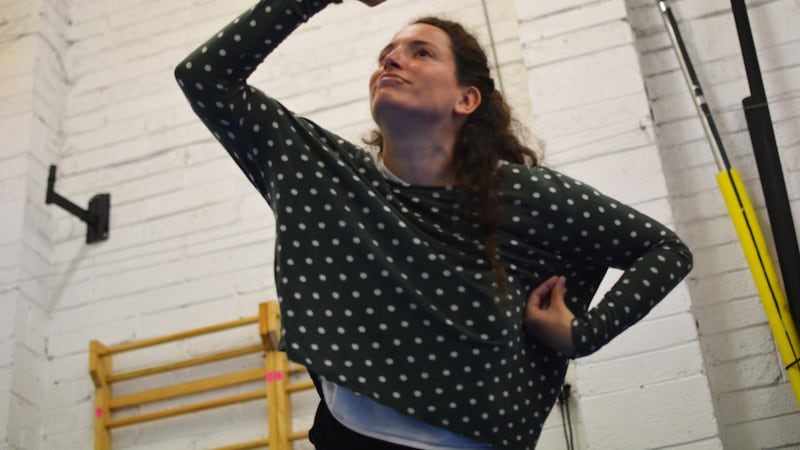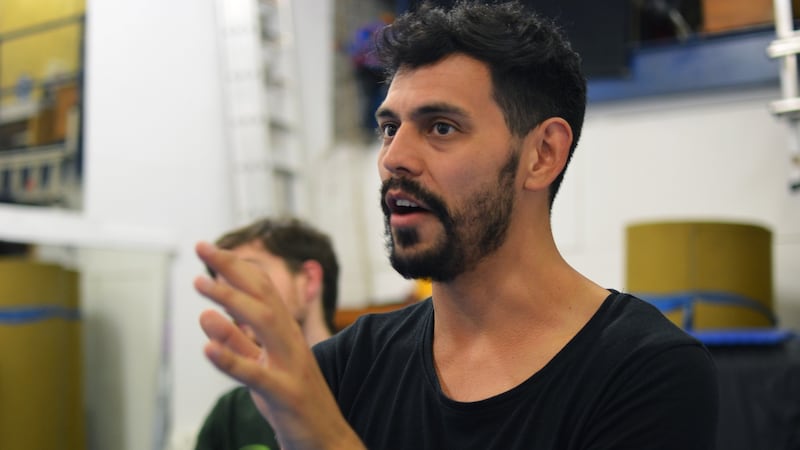On the first evening of my intensive clowning workshop, before class has even begun, I am told something unexpected.
I have arrived a bit early, tucked my belongings in a cubby, and am sitting on one of the blue mats covering the floor. Another participant has parked themselves beside me and we exchange clown-related pleasantries. I am a complete newbie, but they have already done the one-day condensed version of the workshop we were about to embark on last year. Other students trickle in, some stretching their hamstrings and biceps. I copy them while we continue our chat.
Clowning, they tell me, is kind of similar to psychotherapy. Both peel back layers of the self.
I try to hide it, but my brow is probably furrowed. A clown, in my mind, fits a very fixed persona. I imagine a middle-aged man with a clipped-on wig. He is caked in white powder from hairline to chin, the iconic red nose smack in the middle, like a facial bullseye. He is wearing some sort of ill-fitting tweed get-up, coupled with oversized shoes. The routine surely includes crossed eyes and tiny cars, possibly played out simultaneously.
With a clap, our instructor Toto (Ezequiel Olazar), who has come all the way from Argentina, asks us to form a circle. Dublin is one of the later stops of his European clowning workshop tour. He asks us why we came.
In truth, I had stumbled on the workshop on Facebook one day while polishing off a sandwich at my desk. I clicked into a recommended event page, “Clowning Intensive Workshop”, and knew I had to do it. I imagined myself juggling, or precariously balancing on a unicycle. I was elated at the prospect.

When I told friends, my plan was met with raised eyebrows. I was even introduced to someone as, “Kayle, the one going to clown school”.
At the Dublin Circus Project in Cabra, this workshop is hosted by Rather Gather, an inclusive, multicultural arts collective. The organisation brings people together from a variety of backgrounds, offering them alternative ways to connect through culture.
“In this case,” co-founder Romi Cruañas tells me, “we’re helping someone who comes from another country to come and share their skills, and at the same time we’re helping people here to get a different point of view.”
Clowning means childhood
I out myself as a rookie, and admit that for me, clowning means childhood. I don’t elaborate – but I am referring to the aforementioned clown image I came to know as a wide-eyed child in a circus audience.
Toto nods thoughtfully, and grins. He tells us we are here to play. That we will feel a lot. That we are here to learn how to lose. The cherry on top, he says, is that we will actually feel lucky to lose.
I’ve had a lifelong push-and-pull love affair with perfectionism, so, once again, my brow knits.
We start a warm-up that will come to mark the beginning of each class. Within five minutes, I curse myself for wearing jeans. We lift one knee up to our chest, step out into a wide squat, spread our arms out to full wingspan, and rock from left to right.
Toto will tell us each evening to open everything we can – our eyes, our minds, our shoulders. My personal favourite is when he instructs us to open our skin. I’m not sure what that meant exactly, or how to do it, but I love the idea.
Once limber, our stretching is followed by brisk walking to the beat of Toto’s handheld drum. Depending on the day, a series of different commands are shouted out to us.
There are the two staples: “stop”, “go”. One instruction involves us gathering in a circle at a specific point on the mat and creating a simultaneous arm-led wave motion. At the same time, we collectively bellow “whoooooooooa” as we struggle to stay upright.
I giggle in juvenile anticipation when we are told to make a “dedicated jump”. We bound into the air momentarily, one leg leading in a split position, arms outstretched.
Every night involves games that bring me right back to hazy summer camp afternoons. One requires a particular amount of concentration, and any slip-up sends us sprinting around the perimeter of our circle as the game rages on.
When someone inevitably makes a mistake, Toto stops the exercise and faces the culprit, who stands completely still. His palm turned towards us with fingers outstretched, Toto coos, “that’s right. That’s it.”
I’m not entirely sure what “it” is, and blame my lack of understanding on my lack of clowning experience.
“That’s right. Feel the sh*t. Relax into the sh*t,” he says in the same soothing tone. This becomes a recurring mantra, one I come to love.

Failure, it turns out, is an integral part of clowning. Of course, I remember many a clown routine as a kid that involved a literal stumble, rumble and a tumble into a cream pie.
But the failure we become accustomed to in the workshop was different. It is the unintentional kind of failure, akin to the “let-the-ground-swallow-me-up-where-I-stand” variety.
Sitting in that moment, Toto says, you disarm yourself when you realise you’ve failed. When you feel the sh*t, “you become much more human”.
Feel the failure
We all collectively feel the failure for a few more seconds, and then burst back into the game.
Stepping onto the Luas on my way home on that first evening, I feel the fatigue hit me. It is the kind of tiredness you would have felt in your legs after a day in the playground, or on a grassy pitch, where stamina was undepletable and the toll of your exertion was only felt in the aftermath.
Toto was right. We played. A lot.
My daytime work schedule before the second evening of the workshop is a bit heavier than usual, so I dash out my front door with a strongly brewed coffee in hand. Fifteen minutes later, I manage to pour a considerable amount of the much-needed caffeine on my white tee-shirt.
At first, I panic and hold my bag close to hide the stain. But then, I take a deep breath, lower my shield and powerwalk the rest of the way along the canal with the stain on full display. I inform my teacher and fellow participants of my feat when I arrive. “I felt the shit,” I proudly report.
After our warm-up routine, it is my turn to take part in the “pen cap exercise”. As the room erupts with whoops and other distracting sounds made by the class, Toto puts the cap of a pen somewhere on the expansive mat, and I have to find it. With my eyes closed.
Spatial awareness is not a particular strong suit of mine. As a kid, on a spatial reasoning section of a standardised test, I was awarded a single digit-figure, out of a score of 100.
I already knew I was playing at a disadvantage. I would be methodical. I drag my foot around meticulously. Nothing. I drop to the floor and tried a log-roll strategy. Still, no pen cap.
After what feels like several minutes, I lay a flailing hand on it, and triumph. My “failure” to find it more quickly didn’t matter, in the end. I had my pen cap and I was clutching it with pride.
Another game involves working with a partner, shouting out the name of an item or animal, and then imitating it together. In one round, we have to communicate our muse without speaking. My partner and I go through a litany of household pet and farm animal impersonations.
Between the evening classes, friends and colleagues ask how my juggling is going or where I have my red nose stashed. I smile and tell them, that’s what I thought clowning was too. But, it turns out, it’s actually a lot like being a kid, when making a mistake only had hourly consequences.
One night, before class, I sit with Toto and ask him a few questions about the art of clowning. For a good part of our conversation, I try to unpack why failure is so integral to it.
“Because if you don’t accept your failure, you close the door of play,” he says.
After two nights of feeling the sh*t and surviving it, that makes a whole lot of sense to me.
Peak-play
On our last night, we hit peak-play with an exercise that requires us to cross an open room, without being seen. I reach for a nearby foam tile and try to hide behind it as I scuttle my way to the finish line. All that is visible to the crowd is a fingertip that helps move my apparatus along from the bottom.
My master plan is far from foolproof. Toto intermittently shouts, “I SEE YOU!”, and I have to change strategies. There is no apparent logic to it, and by the end, we are all doubled over in laughter.
The very last exercise is an eye-contact one. We take turns holding an uninterrupted, fixed gaze with each participant. This is one of my top-five worst nightmare scenarios. And not just for the workshop, but for life in general. The only time I’ve ever successfully held maintained eye contact was during an optician exam. And even for medical purposes, I found it deeply uncomfortable.
But once I ease into it, it is manageable. It might not be play or failure, but holding the gaze of someone you just met that week for minutes at a time brings a slew of different emotions. And like the wordless nature of the exercise itself, describing it is beyond language.
So, by the end of the week, I haven’t picked up a baton, walked a tightrope, or worn a red nose. Far from funny business, after the workshop, I’m a little more forgiving with myself and I can now maintain eye contact comfortably. For longer than a brief moment.
And that white tee-shirt? It’s still got the stain.








